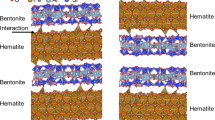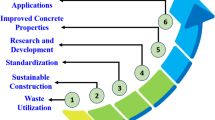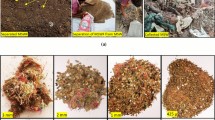Abstract
Phosphogypsum is a kind of acidic industrial byproducts with high content of soluble phosphorus and fluorine pollutants, which requires to be pretreated when used as cementitious material to (partial) replace traditional Portland cement. In this study, five different pretreatment methods were proposed for comparative analysis to examine the pretreatment effect on the mechanical and environmental behaviors of ternary phosphogypsum (PG), ground granulated blast-furnace slag (GGBS), and lime (LM) mixed stabilizer. Series laboratory tests, including unconfined compressive strength (UCS), pH, phosphorus (P)/fluorine (F) leaching, scanning electron microscopy (SEM), and X-ray diffraction (XRD) tests, were conducted to comprehend the macro- and microscopic mechanism. The results show that it is essential to grind raw PG to finer powdered state, so that it reacts more easily and quickly with LM and water. In addition, it was noticed that the UCS and P/F leaching concentration are not only affected by the mixing proportion of the PG-GGBS-LM ternary stabilizer, but also by the curing duration. The UCS increases rapidly from initial curing period and then grows slowly after 28 days of curing. From the perspective of strength evolution, mixing proportion of PG: GGBS: LM = 15:80:5 is optimal, but considering the economy and environmental related issues, PG: GGBS: LM = 30:65:5 was regarded as a more attractive choice. The findings can provide a reference for the selection of pretreatment methods and design of PG-based cementitious materials suited for stabilized soils.









Similar content being viewed by others
Data availability
Not applicable.
Abbreviations
- C-A-H:
-
Calcium aluminate hydrates
- C-S–H:
-
Calcium silicate hydrates
- F:
-
Fluorine
- GGBS:
-
Ground granulated blast-furnace slag
- LM:
-
Lime
- P:
-
Phosphorus
- PG:
-
Phosphogypsum
- PG-GGBS-LM:
-
Phosphogypsum, ground granulated blast-furnace slag, and lime ternary stabilizer
- PG:
-
Phosphogypsum
- SEM:
-
Scanning electron microscopy
- UCS:
-
Unconfined compressive strength
- XRD:
-
X-ray diffraction
References
Alam S et al (2019) State Environmental protection administration. GB-T 11893–89 determination of total phosphorus in water by ammonium molybdate spectrophotometry
Altun İA, Sert Y (2004) Utilization of weathered phosphogypsum as set retarder in Portland cement. Cem Concr Res 34(4):677–680
ASTM D2166M–16 (2016) Standard test method for unconfined compressive strength of cohesive soil. ASTM International, West Conshohocken, PA, USA
Campos MP, Costa LJP, Nisti MB, Mazzilli BP (2017) Phosphogypsum recycling in the building materials industry: assessment of the radon exhalation rate. J Environ Radioact 172:232–236
Chen X, Gao J, Zhao Y (2019) Investigation on the hydration of hemihydrate phosphogypsum after post treatment. Constr Build Mater 229:116864
Contreras M, Teixeira SR, Santos GTA, Gázquez MJ, Romero M, Bolívar JP (2018) Influence of the addition of phosphogypsum on some properties of ceramic tiles. Constr Build Mater 175:588–600
Cui Y, Chang I-S, Yang S, Yu XK, Cao YM, Wu J (2022) A novel dynamic business model to quantify the effects of policy intervention on solid waste recycling industry: A case study on phosphogypsum recycling in Yichang. J Clean Prod 355:131779
Eisazadeh A, Kassim KA, Nur H (2012) Solid-state NMR and FTIR studies of lime stabilized montmorillonitic and lateritic clays. Appl Clay Sci 67–68:5–10
Essaid B, Hajar B, Bourgier V, Hamid M, Delia-Georgeta D, Bard F, Laborde M, Caspar JP, Guilhot B, Elena-Luisa I, Bounakhla M, Măruţa AI, Marincea Ş, Essakhraoui M, Li B, Reymar RD, Jennyvi D, Ramirez YC, Viktoriia C, Hynek R, Horst S, Redouane B, Carlos R, Cánovas JMN, Haneklaus N (2023) Phosphogypsum circular economy considerations: A critical review from more than 65 storage sites worldwide. J Clean Prod 414:137561
Fei X, Fang M, Wang Y (2021) Climate change affects land-disposed waste. Nat Clim Chang 11:1004–1005
GB 3838–2002 (2002) Environmental quality standards for surface water. China National Standardization Management Committee, Beijing, China
GB 5086.2–1997 (1997) Solid waste-extraction procedure for leaching toxicity-horizontal vibration method. China National Standardization Management Committee, Beijing, China
GB, T 11893–1989 (1989) Water quality-determination of phosphorus-ammonium molybdate spectrophotometric method. China National Standardization Management Committee, Beijing, China
GB, T 7484–1987 (1987) Water quality-determination of fluorldeion selective electrode method. China National Standardization Management Committee, Beijing, China
Holanda FDC, Schmidt H, Quarcioni VA (2017) Influence of phosphorus from phosphogypsum on the initial hydration of Portland cement in the presence of superplasticizers. Cement Concr Compos 83:384–393
Jia RQ, Wang Q, Luo T (2021) Reuse of phosphogypsum as hemihydrate gypsum: the negative effect and content control of H3PO4. Resour Conserv Recycl 174:105830
Li XB, Du J, Gao L, He SY, Gan L, Sun C, Shi Y (2017) Immobilization of phosphogypsum for cemented paste backfill and its environmental effect. J Clean Prod 156:137–146
Li BX, Li L, Chen X, Ma Y, Zhou MK (2022) Modification of phosphogypsum using circulating fluidized bed fly ash and carbide slag for use as cement retarder. Constr Build Mater 338:127630
Liu SH, Fang PP, Ren J, Li SF (2020) Application of lime neutralised phosphogypsum in supersulfated cement. J Clean Prod 272:122660
Lu YL, Yang YF, Sun B, Yuan JJ, Yu MZ, Stenseth NC (2020) Spatial variation in biodiversity loss across China under multiple environmental stressors. Sci Adv 6(47):eabd0952
Luo S, Lu Y, Wu Y, Song J, DeGroot DJ, Jin Y, Zhang G (2020) Cross-scale characterization of the elasticity of shales: Statistical nanoindentation and data analytics. J Mech Phys Solids 140:103945
Marshall RE, Farahbakhsh K (2013) Systems approaches to integrated solid waste management in developing countries. Waste Manag 33(4):988–1003
Min CD, Li XB, He SY, Zhou ST, Zhou YN, Yang S, Shi Y (2019) Effect of mixing time on the properties of phosphogypsum-based cemented backfill. Constr Build Mater 210:564–573
Moalla R, Gargouri M, Khmiri F, Kamoun L, Zairi M (2018) Phosphogypsum purification for plaster production: A process optimization using full factorial design. Environ Eng Res 23(1):36–45
Möschner G, Lothenbach B, Figi R, Kretzschmar R (2009) Influence of citric acid on the hydration of Portland cement. Cem Concr Res 39(4):275–282
Peng W, Hu H, Zhang Q, Wang Y, Liu H, Zhang X, Wang C (2023) Simultaneous immobilizations of soluble phosphorus and fluorine in phosphogypsum by milling with calcareous and aluminiferous samples: Reaction products and immobilization performances. J Clean Prod 422:138677
Preethi RK, Reddy BVV (2020) Experimental investigations on geopolymer stabilised compressed earth products. Constr Build Mater 257:119563
Rashad AM (2015) Potential use of phosphogypsum in alkali-activated fly ash under the effects of elevated temperatures and thermal shock cycles. J Clean Prod 87:717–725
Ren HM, Liu WB, Zhang DW (2022) Application of phosphogypsum to solidification of silty soil: Mechanical properties and microstructure. Mech Adv Mater Struct 29(27):6026–6038
Saini G, Vattipalli U (2020) Assessing properties of alkali activated GGBS based self-compacting geopolymer concrete using nano-silica. Case Stud Constr Mater 12(e00352):1016
Shen WJ, Tsai MH, Chang YS, Yeh JW (2012) Effects of substrate bias on the structure and mechanical properties of (Al1.5CrNb0.5Si0.5Ti) Nx coatings. Thin Solid Films 520(19):6183–6188
Silva LFO, Oliveira MLS, Crissien TJ, Santosh M, Bolivar J, Shao L, Dotto GL, Gasparotto J, Schindler M (2022) A review on the environmental impact of phosphogypsum and potential health impacts through the release of nanoparticles. Chemosphere 286(1):131513
Singh M (2002) Treating waste phosphogypsum for cement and plaster manufacture. Cem Concr Res 32(7):1033–1038
Singh M (2003) Effect of phosphatic and fluoride impurities of phosphogypsum on the properties of selenite plaster. Cement Concr Res 33(9):1363–1369
Vaičiukynienė D, Nizevičienė D, Kielė A, Janavičius E, Pupeikis D (2018) Effect of phosphogypsum on the stability upon firing treatment of alkali-activated slag. Constr Build Mater 184:485–491
Wu FH, Chen BJ, Qu GF, Liu S, Zhao CY, Ren YC, Liu XX (2022a) Harmless treatment technology of phosphogypsum: Directional stabilization of toxic and harmful substances. J Environ Manag 311:114827
Wu F, He MJ, Qu GF, Zhang T, Ren YC, Kuang LR, Ning P, Li JY, Liu Y (2022b) Highly targeted stabilization and release behavior of hazardous substances in phosphogypsum. Minerals Eng 189:107866
Wu FH, Ren YC, Qu GF, Liu S, Chen BJ, Liu XX, Zhao CY, Li JY (2022c) Utilization path of bulk industrial solid waste: A review on the multi-directional resource utilization path of phosphogypsum. J Environ Manag 313:114957
Wu J, Liu L, Deng YF, Zhang GP, Zhou AN, Xiao HL (2022d) Use of recycled gypsum in the cement-based stabilization of very soft clays and its micro-mechanism. J Rock Mech Geotech Eng 14(3):909–921
Wu J, Liu SY, Deng YF, Zhang GP, Zhan LT (2022e) Microscopic phase identification of cement-stabilized clay by nanoindentation and statistical analytics. Appl Clay Sci 224:106531
Xie J, Cai Y, Li H, Wu J, Zhao X, Luo K, Sharma A, Xie J, Sun X, Liu H (2019) National environmental protection Bureau GB 5086–1997 toxicity leaching method for solid waste leaching by horizontal shock method
Xu X, Wang W, Lv C, Ma M, Shi L, Du D, Zhang TC, Shen H (2023) Preparation of phosphogypsum-copper smelting slag-based consolidating body with high compressive strength. Environ Sci Pollut Res 30(14):42075–42086
Yang J, Zhu B, Ma LP, Liu HP (2019) Investigation of Al2O3 and Fe2O3 transmission and transformation during the decomposition of phosphogypsum. Chin J Chem Eng 27(5):1125–1131
Zhang M, Zhao MX, Zhang GP, Nowak P, Coen A, Tao MJ (2015) Calcium-free geopolymer as a stabilizer for sulfate-rich soils. Appl Clay Sci 108:199–207
Zhang WY, Zhao LY, Xue MF, Duan XH, Feng CH, Zhu JP (2023a) Effect of oxalic acid pretreatment on the mechanical properties and microstructure of phosphogypsum. Constr Build Mater 362:129631
Zhang QS, Liu ZB, Tang YS, Deng YF, Luo TY, Wang YT (2023b) Mechanical property characterization of mudstone based on nanoindentation technique combined with upscaling method. Environ Earth Sci 82(21):485
Acknowledgements
This study was supported by the National Natural Science Foundation of China (Grant Nos. 52209136, 52279102, and 42272322), and the Open Research Program of the Engineering Research Center of Eco-environment in Three Gorges Reservoir Region of the Ministry of Education (Grant No. KF 2023-05).
Author information
Authors and Affiliations
Contributions
Joseph Roland Atenga Essama: Data curation, Writing – original draft, Investigation. Yunzhi Tan: Supervision, Writing – review & editing, Funding acquisition. Yongfeng Deng: Conceptualization, Writing – review & editing, Formal analysis. Jun Wu: Supervision, Conceptualization, Methodology, Writing – review & editing. Dongming Cai: Writing – review & editing. Wenqi Li: Writing – review & editing.
Corresponding author
Ethics declarations
Ethics approval
Not applicable.
Consent to participate
Not applicable.
Consent for publication
Not applicable.
Competing interests
The authors declare no competing interests.
Additional information
Responsible Editor: Guilherme Luiz Dotto
Publisher's Note
Springer Nature remains neutral with regard to jurisdictional claims in published maps and institutional affiliations.
Rights and permissions
Springer Nature or its licensor (e.g. a society or other partner) holds exclusive rights to this article under a publishing agreement with the author(s) or other rightsholder(s); author self-archiving of the accepted manuscript version of this article is solely governed by the terms of such publishing agreement and applicable law.
About this article
Cite this article
Essama Atenga, J.R., Tan, Y., Deng, Y. et al. Influences of pretreatment methods on the mechanical and environmental behaviors of PG-GGBS-LM ternary stabilizer. Environ Sci Pollut Res 31, 37520–37531 (2024). https://doi.org/10.1007/s11356-024-33740-w
Received:
Accepted:
Published:
Issue Date:
DOI: https://doi.org/10.1007/s11356-024-33740-w




